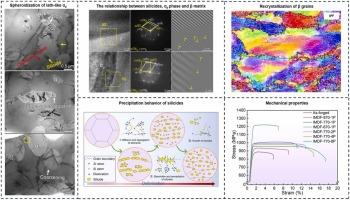The silicide precipitation mechanism and spheroidization behavior of αp phase in a novel near-β titanium alloy during isothermal multi-directional forging process
IF 5.8
2区 材料科学
Q2 CHEMISTRY, PHYSICAL
引用次数: 0
Abstract
The tread-off between the strength and ductility of near-β titanium alloys has significantly limited their applications. In this study, a novel near-β titanium alloy containing Si element was designed, and the influence of α-phase spheroidization and silicide precipitation on the mechanical properties was investigated during isothermal multi-directional forging (IMDF) process. The results showed that the β grain is easy to deform and elongate, and the deformed alloy mainly undergoes dynamic recovery (DRV) rather than dynamic recrystallization (DRX). Some silicides are dissolved due to the temperature rise caused by IMDF and the diffusion of atoms on the top of the irregularly shaped silicides. Zr and Si elements are redistributed and segregated at the dislocation, resulting in the formation of submicron-scale and nano-scale silicides. Lath-like αp phase will precipitate from the prior β grain after heat treatment in the dual-phase region, and the volume fraction of αp phase increases with the decrease of heat treatment temperature. In addition, rotation deformation and spheroidization of the lath-like αp phase occur during multi-pass IMDF in the dual-phase region. When multi-pass IMDF temperature is 770 ℃, the silicide distribution is uniform, and the αp phases are equiaxed, which is conducive to the improvement of ductility. The obtained results provide a new way to prepare the Si-containing near-β titanium alloys with excellent mechanical properties.

新型近β钛合金在等温多向锻造过程中的硅化物析出机理及αp相的球化行为
近β钛合金强度和延展性之间的偏差极大地限制了其应用。本研究设计了一种含硅元素的新型近β钛合金,研究了等温多向锻造(IMDF)过程中α相球化和硅化析出对力学性能的影响。结果表明,β 晶粒易于变形和伸长,变形合金主要发生动态回复(DRV)而非动态再结晶(DRX)。由于 IMDF 导致的温度升高以及不规则形状硅化物顶部的原子扩散,一些硅化物被溶解。Zr 和 Si 元素在位错处重新分布和偏析,从而形成亚微米级和纳米级硅化物。在双相区进行热处理后,αp 相会从先前的 β 晶粒中析出,而且随着热处理温度的降低,αp 相的体积分数也会增加。此外,在双相区进行多道 IMDF 时,会出现αp 相的旋转变形和球化。当多通道 IMDF 温度为 770 ℃ 时,硅化物分布均匀,αp 相呈等轴状,有利于延展性的提高。这些结果为制备具有优异机械性能的含硅近β钛合金提供了新途径。
本文章由计算机程序翻译,如有差异,请以英文原文为准。
求助全文
约1分钟内获得全文
求助全文
来源期刊

Journal of Alloys and Compounds
工程技术-材料科学:综合
CiteScore
11.10
自引率
14.50%
发文量
5146
审稿时长
67 days
期刊介绍:
The Journal of Alloys and Compounds is intended to serve as an international medium for the publication of work on solid materials comprising compounds as well as alloys. Its great strength lies in the diversity of discipline which it encompasses, drawing together results from materials science, solid-state chemistry and physics.
 求助内容:
求助内容: 应助结果提醒方式:
应助结果提醒方式:


